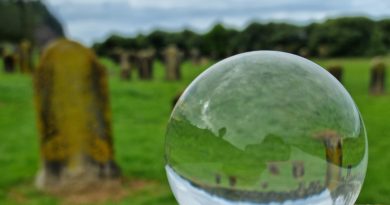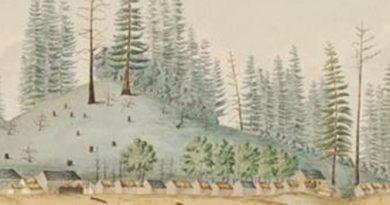Devonshire Street Cemetery Sydney 1819 to 1891
The main research resources for Devonshire Street Cemetery are Keith Johnson and Malcolm Sainty, Gravestone inscriptions, NSW. Volume 1, Sydney burial ground: Elizabeth and Devonshire Streets ‘The Sandhills’ (Monuments relocated at Bunnerong), Sydney Burial Ground 1819-1901 (Elizabeth and Devonshire Streets) and History of Sydney’s Early Cemeteries from 1788; Cape Banks Family History Society, Botany Cemetery, Transcriptions of Pioneer Memorial Park.
A new cemetery for the people of the town of Sydney located to the south of Brickfields called the Devonshire Street Cemetery was opened in September 1819. The previous old Sydney Burial Ground now occupied by the Sydney Town Hall was used for burials from September 1792 until January 1820. The cemetery closed down in 1867, however burials continued by request at the Devonshire Street Cemetery until 1891.
The cemetery became dormant and went into neglect, some 30,000 burials were exhumed and were reinterned at Bunnerong Cemetery Botany (La Perouse) and other cemeteries as per requested by family members in 1901 to make way for Central Railway Station. The exhumation of the cemetery was described as “tearing pages out of our history book, but there are some pages best torn out, although the tearing hurts us, Goodbye – good night – forgotten dead of long ago” (Tracka, Devonshire Street Cemetery, Evening News, 6 July 1901, p.1.)
And so another place in Sydney had been lost to history or was it really, as in 1904 a small booklet was produced called An old and new site: the Devonshire Street resumptions – compiled from authentic sources and illustrated by G. Wendy-Pooley.
Then in 1918 at a meeting of the Royal Australian Historical Society in Sydney, inaugural society members Mr. Arthur and Mrs. Josephine Foster presented a paper and their glass lantern slide images of Devonshire Street Cemetery. The Fosters decided in 1899 to transcribe and photograph many of the headstones, a project that took two years to complete as “her labour of love is finished. The graves of many a pioneer has been preserved for posterity by her camera, and future generations will be able, as we have done tonight, to take a ramble through this historic cemetery”. (Arthur G Foster, ‘The Sandhills: an historic cemetery’, paper presented to the Royal Australian Historical Society, 29 October 1918).
“But eventually the public history awareness and interest in the cemetery became dormant. Not until 1973 when Keith Johnson and Malcolm Sainty published Gravestone inscriptions, N.S.W. Volume 1, which featured the inscriptions of 2825 headstones at Bunnerong Cemetery Botany, that the Devonshire Street Cemetery was once again in the public history arena. Johnson and Sainty continued their research on the cemetery, including the indexing of the Licences to Bury 1867-1888, the cemetery’s re-interment Register 1901 and consulting Mrs. Foster’s photographic collection and Mr. Foster’s headstone transcriptions and the cemetery’s indexes and registers. Resulting in the research collaborated altogether into one publication in 2001 of Sydney Burial Ground 1819-1901 (Elizabeth and Devonshire Streets) and History of Sydney’s Early Cemeteries from 1788, which included the reprint of their out of print 1973 publication.
“The Mitchell Library (ML) in Sydney holds today the Foster’s Devonshire Street Cemetery collection of Mrs. Foster’s 485 glass negatives, five photo albums and Mr. Foster’s papers and headstone transcriptions of Devonshire Street Cemetery – Foster’s Devonshire Street Cemetery Collection, ML, ON 146, PXB768/1-5; PXn860; CY Reels 1040 and 2023. The digitizing of photos was a joint project with the RAHS and the ML.
- Series 01: Glass negatives of Sydney and suburbs c. 1900-1914 / Mrs. Arthur George Foster | ON 146/nos. 1-329
- Series 02: Glass negatives of headstones in Devonshire Street Cemetery, Sydney, and other cemeteries, ca. 1900-1914, Mrs. Arthur George Foster | ON 146/nos. 330-485
Headstone transcriptions by Arthur Foster taken in 1900 – 1901: Series 01: Arthur George Foster papers, 1900-1901 https://collection.sl.nsw.gov.au/record/9O4oA2pn
“The 2,825 headstones that were moved to Bunnerong in 1901, of them only 746 survived when moved once again to the Botany Pioneer Memorial Park in 1976. The Cape Banks Family History Society as a Bicentennial Project in 1987 transcribed the surviving 746 Devonshire Street Cemetery headstones at Pioneer Memorial Park, producing a small booklet of 68 pages. In 2010 the society moved into the digital world by reproducing the booklet onto CDrom with a new title of Botany Cemetery, Transcriptions of Pioneer Memorial Park.
NSW State Archives provide a repository for government records and holds the records of the Devonshire Street Cemetery Board of 1901.
“There is a Facebook group called Old Sydney Burial Ground and Devonshire Street Cemetery. Members include family and social historians, public historians, e-researchers and some history buffs from a diverse range of age groups and historical research interests. The group exemplifies collaborative historical research help, contributing and communication by e-researchers in the public arena on social media and encourages worthy historical practices. The activities and interaction of members are creating their own public history and is not available via another other online system or medium and shows the possibilities of use and the future direction of Facebook for historical research.
“Online access to even more collections and research documentation on Devonshire Street Cemetery will have growth in the future with the changes and future capabilities of technology of producing and publishing historical archives. These resources are suitable for research of family history, burial rituals, monuments, history of the cemetery and burial re-internments. Many e-researchers will say “what did we do before Trove”.
“As we reviewed how Devonshire Street Cemetery is presented today as public history in our digital and online world, we essential must appreciate the work done by Arthur and Josephine Foster back in 1901 with the photography and transcription of headstones, preserving the history of Devonshire Street Cemetery for that we use today and future generations.
© Cathy Dunn: Extract of paper “Devonshire Street Cemetery Sydney in our Digital World”.


